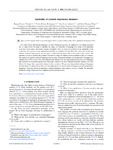Mostrar o rexistro simple do ítem
Optimality of syntactic dependency distances
| dc.contributor.author | Ferrer-i-Cancho, Ramon | |
| dc.contributor.author | Gómez-Rodríguez, Carlos | |
| dc.contributor.author | Esteban, Juan Luis | |
| dc.contributor.author | Alemany-Puig, Lluís | |
| dc.date.accessioned | 2024-01-23T12:55:45Z | |
| dc.date.available | 2024-01-23T12:55:45Z | |
| dc.date.issued | 2022-01 | |
| dc.identifier.citation | R. Ferrer-i-Cancho, C. Gómez-Rodríguez, J. L. Esteban, and Ll. Alemany-Puig, "Optimality of syntactic dependency distances", Physical Review E, vol. 105, 2022, doi: 10.1103/PhysRevE.105.014308 | es_ES |
| dc.identifier.uri | http://hdl.handle.net/2183/35076 | |
| dc.description.abstract | [Abstract]: It is often stated that human languages, as other biological systems, are shaped by cost-cutting pressures but, to what extent? Attempts to quantify the degree of optimality of languages by means of an optimality score have been scarce and focused mostly on English. Here we recast the problem of the optimality of the word order of a sentence as an optimization problem on a spatial network where the vertices are words, arcs indicate syntactic dependencies, and the space is defined by the linear order of the words in the sentence. We introduce a score to quantify the cognitive pressure to reduce the distance between linked words in a sentence. The analysis of sentences from 93 languages representing 19 linguistic families reveals that half of languages are optimized to a 70 % or more. The score indicates that distances are not significantly reduced in a few languages and confirms two theoretical predictions: that longer sentences are more optimized and that distances are more likely to be longer than expected by chance in short sentences. We present a hierarchical ranking of languages by their degree of optimization. The score has implications for various fields of language research (dependency linguistics, typology, historical linguistics, clinical linguistics, and cognitive science). Finally, the principles behind the design of the score have implications for network science. | es_ES |
| dc.description.sponsorship | We are grateful to C. Bentz, N. Català, M. H. Christiansen, M. Gustison, and A. Hernández-Fernández for helpful comments. R.F.C. and L.A.P. are supported by Grant No. TIN2017-89244-R from MINECO (Ministerio de Economía, Industria y Competitividad). R.F.C. is also supported by the recognition No. 2017SGR-856 (MACDA) from AGAUR (Generalitat de Catalunya). L.A.P. is also supported by Secretaria d’Universitats i Recerca de la Generalitat de Catalunya and the Social European Fund. C.G.R. is supported by the European Research Council (ERC), under the European Union’s Horizon 2020 research and innovation program (FASTPARSE, Grant No. 714150), the ANSWER-ASAP project (No. TIN2017-85160-C2-1-R) and SCANNER-UDC project (No. PID2020-113230RB-C21) from ERDF/MICINN-AEI, and Xunta de Galicia (ED431C 2020/11 and an Oportunius program grant to complement ERC grants); the CITIC research center is funded by ERDF and Xunta de Galicia (ERDFGalicia 2014-2020 program, Grant No. ED431G 2019/01). J.L.E. is funded by Grants No. TIN2016-76573-C2-1-P and No. PID2019-109137GB-C22 from MINECO. R.F.C. designed the research; R.F.C and C.G.R. wrote the paper; C.G.R. collected and preprocessed data; C.G.R. and R.F.C. analyzed the data; R.F.C, C.G.R., and J.L.E developed the mathematical arguments; C.G.R., J.L.E., and L.A.P. wrote the core code; all authors verified the mathematical arguments. | es_ES |
| dc.description.sponsorship | Xunta de Galicia; ED431C 2020/11 | es_ES |
| dc.description.sponsorship | Xunta de Galicia; ED431G 2019/01 | es_ES |
| dc.description.sponsorship | Agència de Gestió d'Ajuts Universitaris i de Recerca; 2017SGR-856 | es_ES |
| dc.language.iso | eng | es_ES |
| dc.publisher | American Physical Society | es_ES |
| dc.relation | info:eu-repo/grantAgreement/AEI/Plan Estatal de Investigación Científica y Técnica y de Innovación 2013-2016/TIN2017-89244-R/ES/GESTION Y ANALISIS DE DATOS COMPLEJOS | es_ES |
| dc.relation | info:eu-repo/grantAgreement/AEI/Plan Estatal de Investigación Científica y Técnica y de Innovación 2013-2016/TIN2017-85160-C2-1-R/ES/AVANCES EN NUEVOS SISTEMAS DE EXTRACCION DE RESPUESTAS CON ANALISIS SEMANTICO Y APRENDIZAJE PROFUNDO/ | es_ES |
| dc.relation | info:eu-repo/grantAgreement/AEI/Plan Estatal de Investigación Científica y Técnica y de Innovación 2013-2016/TIN2016-76573-C2-1-P/ES/TASSAT 3: TEORIA Y APLICACIONES EN SATISFACTIBILIDAD Y OPTIMIZACION DE RESTRICCIONES | es_ES |
| dc.relation | info:eu-repo/grantAgreement/AEI/Plan Estatal de Investigación Científica y Técnica y de Innovación 2017-2020/PID2020-113230RB-C21/ES/MODELOS MULTITAREA DE ETIQUETADO SECUENCIAL PARA EL RECONOCIMIENTO DE ENTIDADES ENRIQUECIDO CON INFORMACIÓN LINGÜÍSTICA: SINTAXIS E INTEGRACIÓN MULTITAREA (SCANNER-UDC) | es_ES |
| dc.relation | info:eu-repo/grantAgreement/AEI/Plan Estatal de Investigación Científica y Técnica y de Innovación 2017-2020/PID2019-109137GB-C22/ES/SISTEMAS DE PRUEBA MAS ALLA DE RESOLUCION: ANALISIS TEORICO | es_ES |
| dc.relation | info:eu-repo/grantAgreement/EC/H2020/714150 | es_ES |
| dc.relation.uri | https://doi.org/10.1103/PhysRevE.105.014308 | es_ES |
| dc.rights | ©2022 American Physical Society | es_ES |
| dc.subject | Syntactic dependencies | es_ES |
| dc.subject | Natural language processing | es_ES |
| dc.subject | Syntax | es_ES |
| dc.title | Optimality of syntactic dependency distances | es_ES |
| dc.type | info:eu-repo/semantics/article | es_ES |
| dc.rights.access | info:eu-repo/semantics/openAccess | es_ES |
| UDC.journalTitle | Physical Review E | es_ES |
| UDC.volume | 105 | es_ES |
| UDC.issue | 014308 | es_ES |
| dc.identifier.doi | 10.1103/PhysRevE.105.014308 |
Ficheiros no ítem
Este ítem aparece na(s) seguinte(s) colección(s)
-
GI-LYS - Artigos [43]
-
OpenAIRE [266]






